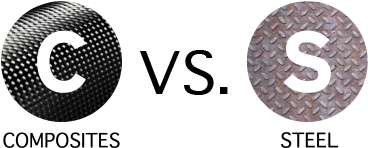Composites vs. Other Building Materials
In the last few decades, composite use in the building industry has grown rapidly, becoming the material of choice for specific applications. Traditional benefits offered by composites are overcoming design limitations, extending lifespans, and reducing environmental and cost impacts.
The molding freedom of composites has also contributed to their popularity in decorative architectural applications, including cornices, columns, domes, cupolas and balustrades. But today, composites in architecture extend far beyond décor into structural applications. Innovative companies are using custom-fabricated composites for cladding panels and building facades in commercial and residential buildings.

- Composites are lighter and can be designed to be far stronger than steel. While steel is equally strong in all directions, composites can be engineered and designed to be strong in a specific direction.
- Strength-to-weight ratio is a material’s strength in relation to how much it weighs. Some materials are very strong and heavy, such as steel. Other materials can be strong and light, such as bamboo poles. Composite materials can be designed to be both strong and light; they have the highest strength-to-weight ratios in structures today.
- Additionally, a single composite piece can replace an entire assembly of steel parts. Reducing the number of parts in a machine or a structure saves time and cost, while reducing maintenance over the life of the item.
- Unlike aluminum, composites have low thermal conductivity. Composites are good insulators—they do not easily conduct heat or cold. They are used in buildings for doors, panels, and windows where extra protection is needed from severe weather. While aluminum is subject to oxidation, composites are naturally corrosion resistant.
- Composites can be molded into complicated shapes more easily than aluminum, which often requires additional, costly labor and must include fasteners or joints. Composites give designers the freedom to create almost any shape or form. The surface of composites can also be molded to mimic any surface finish or texture, from smooth to pebbly.
- Composites resist damage from the weather and from chemicals that can quickly degrade other materials like wood. Composites are a solid choice for any harsh or exposed environment. Outdoors, they stand up to severe weather and wide changes in temperature that could damage wood more easily.
- Structures made of composites have a long life and require little maintenance. We do not know how long composites last, because we have not come to the end of the life of many original composites. Many composites have been in service for half a century.
- Composites also have very low thermal conductivity compared to wood and other materials. They are used in buildings for doors, panels, and windows where extra insulation is needed from severe weather.
